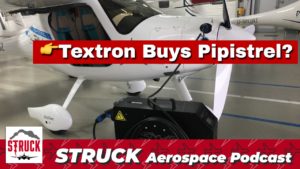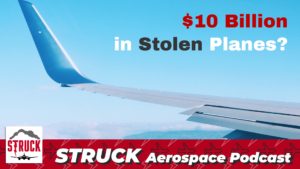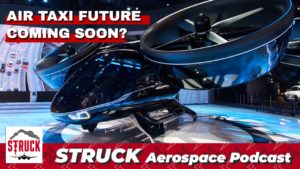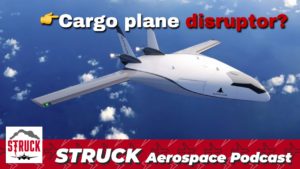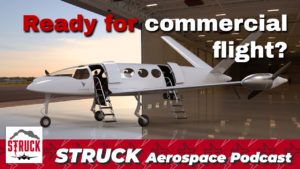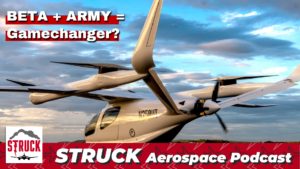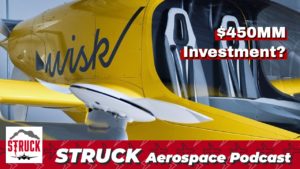Joby Aviation has released numerous patents, giving a glimpse into their technology. Bye Aerospace partners with Korean company Aerospace9 in what looks like a very lucrative deal. Spirit Aerosystems revealed Q3 results, and we discuss the future of the Airbus A380, which one airline recently has phased out of commercial use.
Learn more about Weather Guard StrikeTape segmented lightning diverter strips. Follow the show on YouTube, Twitter, Linkedin and visit us on the web. Have a question we can answer on the show? Email us!
Podcast: Play in new window | Download
Transcript EP34 – Is the Airbus A380 Going Away? Bye Aerospace Gets Key Partnership & Joby Aviation Releases Patents
You’re listening to the struck podcast i’m Dan Blewett i’m Allen Hall and here on struck we talk about everything aviation aerospace engineering and lightning protection all right welcome back to the struck podcast this is episode 34 and on today’s show we’ve got some news some engineering and some evtol action for you today so number one we’re gonna chat about the A380 one of airbus’s largest offerings uh kind of being phased out it sounds like a recent incident with an a320 that was not down per se not almost down i don’t think it was really almost down but it sounds like the pilots were very heavily effective which put them in a really scary situation uh by fumes coming in the cockpit which is crazy also we’re going to chat a little bit about spirit era systems third quarter results and some optimism from their leadership in our engineering segment we’re going to talk about by aerospace they’ve got an investment from a Korean company which sounds promising and lastly in the evtol segment we’ll chat about Joby who has recently filed a bunch of patents which is starting to shed some light on some other technology so Allen first let’s start with the a380 so Hi-fly which is one of only apparently 15 companies that ever leased or operated uh the a380 because they’re such a darn big aircraft but they said they’re planning to phase this out they’ve done three years of of leasing it and now they’re gonna kind of move forward and swap their a380s for more a330s so is this a trend that you expect to continue yeah that’s why the 747 has gone away also and that in the triple 7’s having a little bit of struggle on the new development side is four engine airplanes and large uh multi-aisle airplanes are going away because international travel has gone to zero and it doesn’t make any sense to have four engines anymore and as we there’s some huge consolidation in the industry the a380 is is and it seems hard to believe because it hasn’t been around all that long but the a380 it’s going away and it’d be in a couple of years you won’t be able to see it really maybe besides the museum and it’s hard to think about the evolution of aircraft because we there’s some aircraft that have been around so long that you just come ubiquitous that you could say 747 to pretty much anybody in the planet and they even know what you’re talking about but they’re in that same cycle there’s been all kinds of airplanes that have come and gone and it takes a very unique aircraft to last tens and twenties and thirty year spans it just doesn’t happen all that often so uh it is special that some of these airplanes have lived as long as they have and been in service as long as they have the a380 really wasn’t one of them it was pushing a particular segment of the aircraft market the the large volume traffic market the upper end of the marketplace for the most part uh because you’re burning a bunch of fuel and it just never and long haul too so it just didn’t really make any sense after a while and and even though fuel prices are low right now it just there’s just not a customer base for it it just really isn’t and i think you’ll see a lot of other airplanes kind of get stuck in that same mold anything that is really dedicated international travel routes is going to have problems for the next year or two until things settle out from coven and there’s nothing to do about it which is the sad part because you know there’s been a ton of work and engineering time to go into a380 and all the other airplanes that serve the international marketplaces and it’s just being idled essentially which is never good because we need to have the ability to move across the planet and right right now we’ve essentially shut it all down uh which is just not good you see that in the employment numbers for like boeing and airbus and a bunch of other aircraft manufacturers mitsubishi sounds like they’ve they’re mop balling their space jet that that is you know sort of expected in sort of economic conditions we’re in today but the trouble is is that you start losing a lot of the engineers and the talent that you had to develop those projects and they wander off and do something else and when you have to get to the next a380 type project they’re not coming back because the turbulence in the aircraft market is for a certain segment of society it just is it’s a it’s a hard life and it doesn’t necessarily seem like it seems like a glamorous life you get to drink coffee and sit in conference rooms all day but it’s actually a pretty difficult life and once you lose the engineers from what i’ve seen 50 of them will come back maybe maybe they’ll find some other places more stable and that’s the trouble yeah so this isn’t that old of an airplane either especially compared to the 747 i mean this is 2005 the first prototype was revealed yeah and uh so i mean who’s going to take the loss on this i mean is it the leasing companies or it’s airbus is airbus leasing well yeah well it depends on you know when you have a lease situation ever it’s just like a rental car every mile that you it’s in use you’re making money on someone’s paying you for that opportunity to fly the aircraft so the leasing companies don’t tend to do too poorly in those transactions as long as the aircraft is being leased and flown you’re happy it just comes about when they you own this aircraft and it’s parked that you start to take it uh in on the negative column you start to go into the red on the economics of it and on an air a380 i’m sure the thought process was this aircraft could fly 40 50 years we can be making money we can be making money 30 40 years out with the same aircraft possibly that’s a remarkable feat if you can pull it off and a lot of aircraft after the 20 years span kind of tend to go away but you know something that large you tend to want to keep it around and treat it nicely so you can make big dollars because everything’s paid for essentially once you get past about years six or seven on that on as the owner hopefully you paid it off and the rest is just cash but yeah so it’s hard you know i think probably the the the companies have lease a380s have made their money and have a little bit of income but that’s going to stop now well speaking of airbus an a320 and this such a striking such a weird story that basically a a cessna citation owned by netjets uh took off like a minute before an airbus a320 operated by vueling probably pronouncing that wrong um and basically like the cabin filled with fumes and the pilots were reported fumes from the cessna they basically told on them and uh so but they had some real real were really affected by it i mean one of them went to the to the to the toilet to uh i don’t know i mean they were so nauseous that both of them were very heavily affected and uh i mean this creates a really serious situation and i mean you wonder like if what if it’s the cabin door was closed and they both just passed out you just didn’t know i mean i guess that could potentially happen obviously but i said seven minutes after taking off that you know the uh the crew was really monitoring the cabin and or the the pilots and just a really strange hazardous situation and they’re not exactly sure why this went down like that but i mean is this is this really that abnormal or this strikes me as pretty weird i think it’s abnormal usually the the airbus and the boeing airplanes their air inlets are well they suck in air for to provide pressurization tends to be under the wing or in that fairing underneath the wing there’s packs in there that bring in the fresh air so i kind of wonder if it’s a just the size of the citation versus the a320 because the citation’s relatively low to the ground but is it on the same level as the incoming air inlets for the airbus and if they if usually i don’t know if you ever stood behind a jet airplane it smells you can see you can smell the burnt kerosene coming off the back side of that thing it is can be overpowering and that’s why you don’t stand there but if they happen to suck that in into their environmental control system on the airbus you may not really notice you may not really notice it i always think kerosene has a kind of a sweet smell to it now and you know you’re around an airport because you can smell that jet fuel that kerosene burning and i’m surprised that pilots didn’t think wow that’s weird i’m smelling kerosene but along with that kerosene smell are the byproducts of combustion which one is carbon monoxide so if you’re sucking in a bunch of carbon monoxide into the environmental control system for the airbus you would get really sick i think because the filtration system wouldn’t remove the carbon monoxide and you know carbon monoxide poisoning kills a lot of people uh a year and the the symptoms are one of the early symptoms are is that uh like your features get red like your lips start to get bright red right and then you start to get this nauseous feeling again they get light headed and dizzy and those are always the markers like hey i got to get some fresh air well in an airbus cockpit you can’t just i don’t think you can well you can’t roll down the window for sure i’m not sure if you can pop the windows out somewhere if you kind of pop the windows out get some fresh air in but you wouldn’t be thinking about that at the time yeah so it is weird that the pilots let that go on and got to the point where they got nauseous like that’s pretty serious stuff yeah because it when your brain is not getting the right amount of oxygen that’s why you’re feeling sick so if you’re not thinking straight you’re not flying straight and that’s rule number one always have all your mental capacities working at full speed when you’re flying yeah absolutely that’s that’s definitely scary so shifting away from airbus uh so one of boeing’s major suppliers is Spirit Aerosystems and Allen what components do they produce the fuselage is that right but lots of other things large large sections of aircraft yeah wings fuselage yeah so really good article from composites world uh basically spirits third quarter revenue this year was 806 million down from 1.92 billion in the same quarter last year uh yet even though they’ve laid off 8 000 employees this year and closed a plant in oklahoma um you know there’s some optimism and it seems i don’t know they seem some kind of sunny statements from their leadership uh despite that so how do you feel about Spirit Aerosystems and this uh this announcement well that’s a delta of a billion dollars right is that what you just read off to me a billion dollar delta between last year and this year wow that’s a lot of money uh i i know there’s had a lot of layoffs happen at spirit just trying to keep the cash flow somewhat controlled because all the aircraft manufacturing is essentially down to a snail’s pace there’s not much moving out there and if you’re building the the large sections of aircraft you want to continue to do that but it’s going to be done at a reduced rate and that reduce rate means you just need less labor and you’re just going to start cutting overhead as much as you can to to to keep the production line open but i think they’re you know on a larger scale company like that they’re desperately needed as a sort of vital piece to boeing and other aircraft manufacturers success spirit sort stationed itself as like a real structural expert and they are they’re they’re they make fantastic components in structural sections so i i think that they’re seeing that there’s going to be a little bit of uptick probably into this year beginning of next year they can just weather through it and get six months down the line you may get to back to some level of normalcy even if that was just at 75 the normal rate i think they’d be happy with that and boeing would be two airbus everybody’s gonna be happy with that if we can get to that point uh but we need to make sure that we don’t lose like i was saying before we don’t want to lose all the all the special people that make those aircraft parts as good as they are because they’re hard to get back one optimism is that they’ll get back to profitability um or positive free cash flow by 2022 and a lot of that is with the 737 coming back online on the 737 max so they’re eagerly awaiting that aircraft’s return all right so in our engineering segment today we’re going to chat about by aerospace so they’ve got an investment from a south korean company called aerospace nine and they’ve also agreed to purchase 300 of their all-electric aircraft and uh yeah so it seems like a pretty so it sounds like they’re gonna do a hundred fifty e flyer twos and 148 e flyer fours which is the four seat variation and two right on two envoys which is their uh their nine seater that they’re soon i’m gonna be announcing so it’s a pretty big deal alan and i know uh yeah you know you’re very aware of uh by aerospace so what uh what are your thoughts initially about this partnership i i hadn’t seen a lot about that announcement besides that it had happened i didn’t realize that they had sold it many aircraft that’s a fantastic sale just because if they’re selling at that high of number of aircraft during a pandemic if they can get to 2022 then the sales may really skyrocket but the the whole key to to buy aerospace and all the electric aircraft companies is that the reduced cost of ownership not so much that the aircraft is less expensive this aircraft are expensive relatively speaking to an automobile or a house for that matter but if you can keep the operation operational costs down if you’re running a flight training school or if you’re running training air force pilots in south korea it may be a good fit because operational expenses add up over time and if you plan to keep the aircraft around for a long time those operational costs keeping them down really is a huge long-term savings and i think that’s why you’re seeing so much interest in the electric aircraft market is this just the operational costs are so much lower you’re not you’re not burning fuel you’re not storing fuel uh you’re not repairing an internal combustion engine so the maintenance times would be down uh you can do a lot of unique things with the aircraft design because the the motors are so small compared to an internal combustion engine if you think about i know Dan you’ve worked on cars before so you know like a chevy 350 engine and this is kind of the size of an aircraft motor roughly that’s on a you know a single engine uh piston airplane and now you get motors that are like and i’m gonna put this in perspective like a record a vinyl record in the old days it’s about that diameter and it’s about maybe i don’t know less than a foot deep somewhere in there they’re tiny compared to an internal combustion engine but they produce a tremendous amount of torque and horsepower so it just opens a door tremendously to aerodynamic savings fuel savings maintenance savings and yeah i think this is a good indicator for that whole industry that there is going to be a big demand pull if they can get the aircraft certified and and buy is well on their way to getting that done they’ve they’ve got a great engineering uh crew out there in colorado and i i you know it’s just a matter of getting the aircraft done which i think they will get done and so can you speak to that market a little bit so these are the e-flyer is a trainer aircraft so for those who are in the industry like what is a trainer aircraft for like who buys them i mean where does this fit into the aviation world uh there’s really two marketplaces it’s just the average consumer that wants to learn how to fly there’s a lot of flight training schools around the world and they tend to have several aircraft and it’d be an epicenter so if i have a flight training school say in silicon valley i may have 20 aircraft in my fleet because it’s like any other rental company the more they fly the more i get paid and the more and that the flight training costs are relatively expensive and you have a flight instructor with the novice pilot going out to fly around and you so there’s there’s a profit to be made there so from a financial standpoint if you can entice new pilots into the program it’s it can be can make some decent money and especially if you can lower the operational cost for that new pilot because the first sticker shock you get is like the cost of fuel and the cost to to essentially rent the aircraft for an hour can add up so you you find this sort of d line of demarcation on at what uh level people can’t afford to do it so you have to have income levels let’s just say above a hundred thousand dollars a year maybe two hundred thousand dollars a year to really go after it not necessarily but if i think it kind of it takes a sort of money because it’s expensive it just is but if you can lower it yeah it’s not yeah but if you can lower those training costs down and you entice more people into their industry yeah i think it can make sense financially because a lot of people want to learn how to fly and especially with this EVTOLs coming around because somebody’s got to learn to fly those things and in the second market is really the the military side there’s like the air force academy in colorado which uh trains i think they’re trained pilots and gliders and cessnas or cirruses i forget what they have are diamonds i forget what they have out there but in that first entry level aircraft you don’t want to be a super acrobatic type of aircraft you want to be a very docile recovery stable recovery kind of aircraft so these new pilots can learn how to fly and so there’s really two marketplaces there and you can think about the number of pilots that go through military training around the world it’s it’s a good number of pilots and they have to start somewhere and the e flower two is probably a pretty good baseline for most of them
all right in our final segment today we’re going to chat a little bit about Joby aviation which joby is one of the leaders for sure they seem to be pretty stable like firmly out ahead of of many of the other challengers here in the uh the air taxi market all we know whatever you want to call it but some interesting news out of evtol.news electrical vertical takeoff and landing dues and they put out tons of really great information so definitely go check out their website they’ve uh joby has released a lot of patents and so Allen what is why is that significant i mean this seems newsworthy but what’s the big deal about patents well it locks in the technology so that no one else can use it or if they want to use it they have to pay you for it uh it’s sort of like what tesla has done but you know tesla let those patents be used for free to grow the industry but joby has a number of interlinked patents having to do with um the way they articulate the thrust so the the on if you think about like a v22 which is a tilt rotor and they have these big turbo fan engines on the ends of the wing those whole engines rotate so the whole pylon and assembly around them rotate to get from a vertical flight to horizontal flight well when you use an electric motor the motors are relatively small so you don’t have to rotate the whole pylon assembly you can just basically leverage out the motor and flip it 90 degrees and reduce the drag one and two the complexity of the whole thing if you can just mechanically flip the motor out and go to horizontal vertical flight from a horizontal flight so there’s a lot of little tricks you can do because these motors are so dang small that and i think that’s where a lot of the technology is and obviously so you’ve got other problems which joey is trying to address which are battery cooling always a problem motor cooling always a problem and then some aerodynamic aspects around motor cooling it looks like uh and there’s there’s a whole pile of patents there i’m not sure well a lot of our applications still at least i was just looking online here a little while ago some of those still applications music got to go through the process which seems to be a two to three year process which there’s a lot of people gonna there’s a lot of big players in that market space right now so someone uh can can go after it and say yeah i already invented that and so there’s a process involved with patents which is painful and expensive so so if they do get patents that’s that’s great but just um you know it gives you an insight into what the design of the of their aircraft is going to be which is more exciting and if you can sort of piece things together you can get a sense of where they’re going which is taking advantage of one this the simplicity and the compact size of an electric motor and two uh leveraging the flexibility that comes with electric power and if you can do those two things efficiently then you can set yourself apart in the marketplace and joby has uh funding from toyota right so
if toyota’s hopefully is helping them because toto has a lot of mechanical knowledge matter of fact you know how to know how to do a lot of strange mechanical things and again sometimes toyota does think out of the box particularly uh and some of the race teams they just tend to think out of the box so they can bring something to the table there but i think it’s interesting that joby is really clicking down the line in terms of creating patents and creating usable usable technology that they they think has value to them and they’re going off and patenting it which is fascinating because we haven’t seen that out of a lot of the other e retail companies we haven’t seen a lot of patents come out we’ve heard a lot of discussion about you know ip they have technology but if you start really searching deep you don’t see a lot there joby thinks they have something
all right well that’ll do it for today’s episode of struck if you’re new to the show thank you so much for listening and please leave a review and subscribe on itunes spotify or wherever you listen to podcasts check out the weatherguard lightning tech youtube channel for video episodes full interviews and short clips from the show and follow us on linkedin twitter instagram and facebook our handle is at wg lightning tune in next tuesday for another great episode on aviation aerospace engineering and lightning protection strike tape weatherguard lightning tech’s proprietary lightning protection for radomes provides unmatched durability for years to come if you need help with your radon whitening protection reach out to us at weatherguardarrow.com that’s weatherguard aero.com



